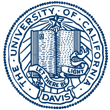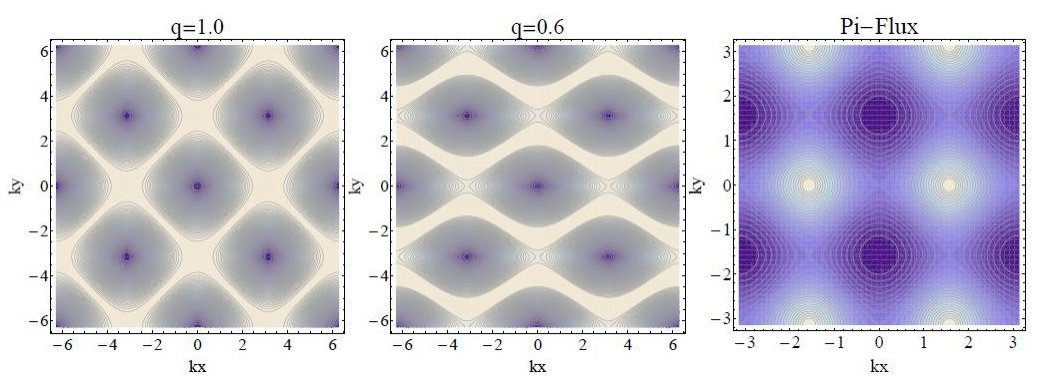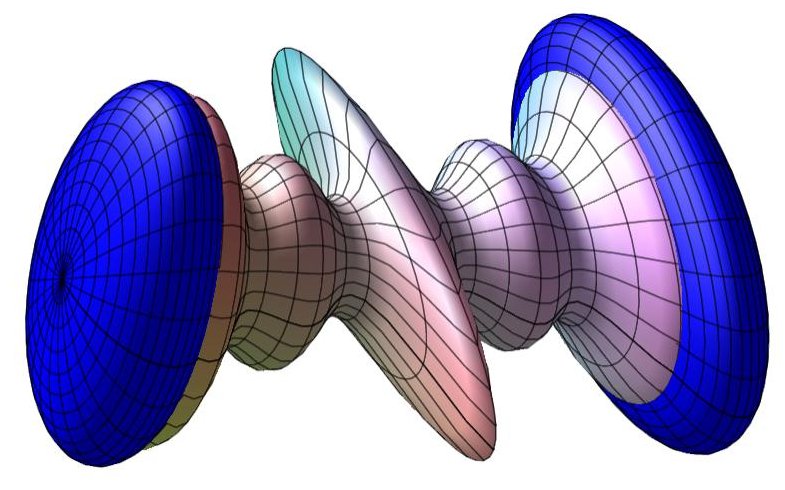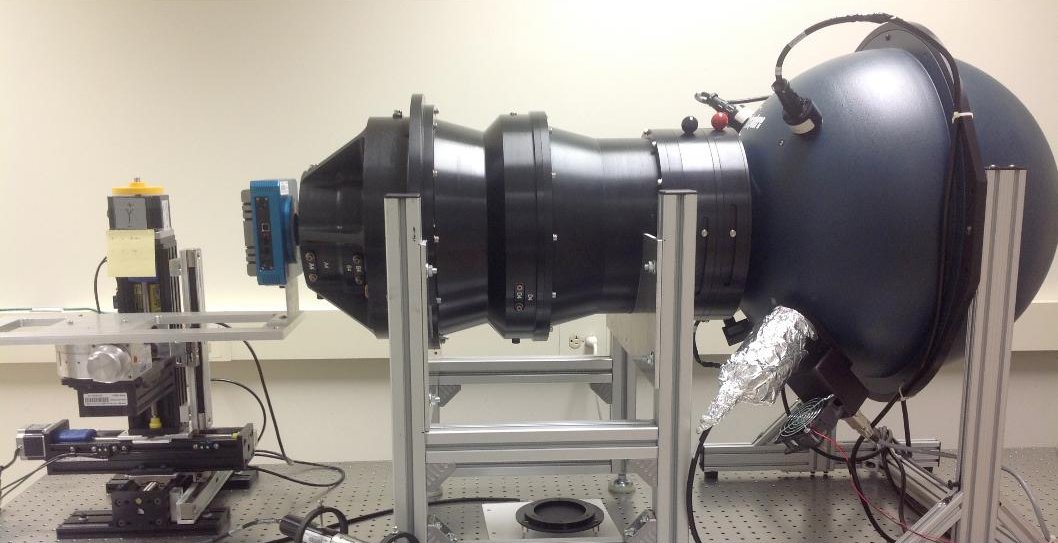
This REU program was funded through NSF PHY-1263201.

Students' names link to their final papers. Advisors' names link to the research group web pages. Papers are included from a few additional students who were not formally part of the REU program but participated in the REU activities.
Condensed Matter, Theory and Experiment
Emily Hemingway (St. Olaf College; advisor Rena Zieve) measured what causes a superfluid vortex to break out of a metastable location. Using a refrigerator that cooled liquid helium to about 300 mK, Emily first created a vortex by rotating the refrigerator. After the rotation stops, the vortex often settles in place around a thin wire. Emily then heated the refrigerator to make the vortex come off the wire, testing the effects of several different heating profiles. She found that the depinning is closely tied to the maximum heating rate. Since fluid flow accompanies heating in superfluid helium, this suggests that the mechanism is related to the flow velocity.
Maddie Mailly (Middlebury College; advisor Shirley Chiang) studied how a few monolayers of Iridium arrange themselves on a Germanium surface. She varied both the amount of Iridium and also the heat treatment it received after the initial deposition, then imaged the surface with a scanning tunneling microscope at near-atomic resolution. She found that under most conditions the Iridium formed elongated islands on the surface, with the long directions all aligned. However, for a relatively large amount of Iridium and a high annealing temperature, the islands took on two orientations in perpendicular directions. Future work will set better limits on the temperature and Iridium concentration required for the change in behavior, and will also test whether the duration of the heat treatment is an important factor.
Liam McAloon (Whittier College; advisor Richard Scalettar) set up a model for how magnetism could work in a sample constructed from randomly oriented nanowires. (Professor Kai Liu's lab is growing such samples.) He based the model on an Ising model, where particles have spin-1/2 which can be oriented up or down along a single axis. Typically each spin interacts with its nearest neighbors on a lattice. At high temperatures entropy considerations mean that the spins are disordered, half up and half down. At low temperatures, the spin-spin interactions can overcome entropy and lead to magnetic ordering. Liam began by removing spins in a regular pattern from a 2-dimensional grid, to simulate a sample with regular vertical and horizontal nanowires. For this arrangement he found a transition to magnetic ordering. Then, to model irregular samples, he again started from a lattice but this time removed all spins except those that formed line-like structures in various directions. He found some preliminary hints of magnetic ordering here as well. Running more calculations and extending the results to three dimensions remains to be done.
Daniel Silva (CSU Long Beach; advisor Rena Zieve)
worked on updating image analysis software to a new experimental
setup. The software identifies the types and locations of the grains
in a binary mixture. The overall goal is to understand how the exact
arrangement of grains influences the stability of a granular pile.
In addition to translation from IDL to Python, the new setup uses
different hardware and is in a new location with different lighting. These
changes require corresponding adjustments to the analysis programs.

Justine Tang (University of the Pacific; advisor Rena Zieve) looked at avalanches in an artificial sandpile. She successfully measured hundreds of avalanches using an automated data acquisition system. An eventual goal will be to determine how the precise configuration of grains within the pile affects the angle at which an avalanche begins. One approach is to sort through avalanche angles and look for patterns that appear at the highest (or lowest) angles. Justine took the opposite approach, sorting the grain configurations immediately before the avalanche and looking for patterns in the avalanche angles of the different types of configuration. One finding was that in the dimer-hexagon piles, configurations with all the hexagons well away from the free surface never reached the highest observed angles. This work will be continued after improvements to the analysis software.
Complex Systems
Brenden Roberts (Clemson University; advisor Jim Crutchfield) studied irreversibility of certain fairly simply processes. He considered what properties of a process make it irreversible, and found two that lead to different levels of irreversibility. Brenden's work is a start towards understanding irreversibility more generally, in more complicated situations.
General Relativity
Kyle Lee (Chapman College; advisor Steve Carlip) continued the Causal Dynamical Triangulation project (CDT) that several previous REU students have pursued. Path integral formulations for quantum mechanics are used to calculate the probability of reaching a given final state from a given initial state. Each possible path between the states is considered, with a weight factor depending on its likelihood. (An additional complication is that there is interference between paths.) Extending this approach to gravity would mean considering initial and final configurations of spacetime, and paths by which spacetime could evolve between them. CDT approaches the question numerically, discretizing spacetime into a collection of tetrahedra and applying operations that change the spacetime by altering the tetrahedra. Previous work in Professor Carlip's group had extracted information from simulations with the same initial and final spacetimes. Jonah extended the work to calculations where the initial and final states were both specified but were not identical. He showed that many of the earlier results agree with those of his more general case, and that at least one known sickness of the earlier data disappears once the initial and final states are not identical.

Nuclear and Particle Physics Experiment
The Relativistic Heavy-Ion Collider (RHIC) produces head-on collisions that blast apart nuclei into a quark-gluon plasma (QGP). The temperature and density of the QGP are determined by the speed of the ions and how on-center their collision is. Exploring the phase transition between the QGP and a hadronic gas requires lower speeds than RHIC currently produces. One option is to collide a single relativistic ion with a fixed target. Kyle Bilton (Moreno Valley College; advisors Manuel Calderon de la Barca Sanchez and Daniel Cebra) analyzed how such a setup would work, using accidental collisions of relativistic ions with the aluminum pipe that contains the beam of ions. He found that the detector appears to work for this type of collision, despite its original design for collisions of two oppositely moving ions.
Jamison Blanchard (CSU Sacramento; advisor Mani Tripathi) simulated how the Large Underground Xenon detector would respond to interactions of dark matter with xenon nuclei. The experiment searches for a particular dark matter candidate known as Weakly Interacting Massive Particles (WIMPs). Although it is difficult to know exactly how a particle that has never been observed directly will interact, Jamison used some plausible assumptions to generate the types of signal that could indicate the detection of WIMPs. Even if nothing is observed, these calculations are needed to establish the sensitivity of the experiment and know exactly what parameters for WIMPs it rules out.
Alberto Candela (Instituto Tecnológico Autónomo de México; advisors Manuel Calderon de la Barca Sanchez and Daniel Cebra) modelled how gold-gold collisions could be distinguished from gold-aluminum collisions in a fixed target experiment at the Relativistic Heavy-Ion Collider. (See Kyle Bilton's related project, above.) Naturally any uncertainty about the species of atoms involved in a collision will affect subsequent analysis of the event. By looking at simulated events, Alberto tested how well different criteria would reject gold-aluminum collisions, and also what fraction of the gold-gold collisions they would accept. In an actual experiment there will then be a tradeoff, which may depend on the exact physics under study: ideally all gold-aluminum events will be rejected, while all gold-gold collisions will be accepted.
Daniel Palken (Bowdoin College; advisor Bob Svoboda) did design work for a new neutrino experiment which will look for violation of charge-parity symmetry. The experimental detector is a vat of liquid argon. Neutrinos will interact to create both photons and argon ions. An applied electric field will direct the ions to electronics at the wall of the container. There will also be photomultiplier tubes (PMTs) placed around the edge of the vat to detect the photons. Daniel set up simulations that will model possible arrangements for the PMTs, to see how well each option can pinpoint the location of neutrino/argon interactions in different parts of the chamber.
Jessica Phillips (CSU Sacramento; advisor Mani Tripathi) worked on data analysis to determine the effect of radon impurities in the Large Underground Xenon dark matter detector. Much of the radon came from contamination of the experimental apparatus during its installation. (The overall level is low, but the experiment is extremely sensitive.) Jessica simulated background events from the walls of the xenon bath, which are generally coming from radon contamination, and looked at how to distinguish such events from possible dark matter signals. She also considered how to deal with events with an unphysical shape because the detector was at its maximum level for a portion of the signal.
Detectors for various neutrino experiments involve huge vats of fluid surrounded by photomultiplier tubes (PMT's). A neutrino interacting with an atom within the fluid creates photons which are ultimately captured by the PMT's. Salomon Wollenstein (Instituto Tecnológico y de Estudios Superiores de Monterrey Campus Santa Fe; advisor Bob Svoboda) studied how the photons interact with the fluid before they reach the PMT's. The specific interest here is in developing a detector for a particular type of decay that, if observed, would prove the neutrino to be its own antiparticle. Salomon's calculations help in considerations of the ideal size for the detector.
Astrophysics
One handle on the very early universe is the Cosmic Microwave Background
(CMB) radiation. The CMB has a nearly uniform temperature of 2.7 Kelvin,
but the pattern of fluctuations (which have typical size 0.000018 Kelvin)
is a key test of the model of the Big Bang and subsequent inflation.
Jennet
Dickinson (Columbia University; advisor Lloyd
Knox)
analyzed how a particular coupling between dark matter and dark energy
would appear in the CMB. Professor Knox's group participates in the Planck
Survey, which does precision measurements of anisotropies in the CMB, so
ultimately these calculations will be compared to data.

Jordan Dudley (CSU East Bay; advisor Tony Tyson) helped set up CCD testing for the Large Synoptic Survey Telescope (LSST). Analysis of the telescope images will require a better understanding of CCD response than presently exists; in particular, one question is whether there are any differences between the pixels near the center or edge of a CCD. Jordan worked on the hardware (pictured above) and corresponding LabView software that will shift CCDs to a varety of positions and angles with respect to a beam of light, and then record their response. He also worked on Python scripts needed to analyze the results.
The composition of stars affects the light frequencies they emit. Samantha Thrush (Ohio University; advisor Matt Richter) worked to identify the emission lines of a particular star, focusing particularly on the signal expected from water. The star in question was already known to contain water; the eventual goal will be to use this analysis analysis to learn about other stars. By the end of the summer Sam had calculated spectra that were similar to the star's observed spectrum, but with some puzzling differences remaining. One possibility is that the trouble lies in the data rather than the calculations, but resolving this is a project for the future.